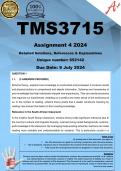TMS3715
Assignment 4 2024
Detailed Solutions, References & Explanations
Unique number: 652142
Due Date: 9 July 2024
QUESTION 1
1.1. (2 ANSWERS PROVIDED)
Schema theory, explains how knowledge is constructed and processed. It involves mental
and physical actions to comprehend and absorb information. Schemas are frameworks of
prior knowledge that help individuals interpret new experiences. They are mental structures
that organize our experiences, enabling us to predict and make sense of the world around
us. In the context of reading, schema theory posits that a reader constructs meaning by
relating new textual information to their existing knowledge.
Relevance in the South African Classroom
In the modern South African classroom, schema theory holds significant relevance due to
the country's cultural and linguistic diversity. Learners bring varied backgrounds, customs,
and knowledge to the classroom. By leveraging these existing schemas, teachers can make
reading more relatable and understandable for students. This is particularly crucial in a
multilingual environment where learners might need to decode texts in a second or third
Terms of use
language. Schema theory, by emphasizing existing knowledge,
By makinghelps
use of in
thisbridging
documentthe
yougap
agree to:
• Use this document as a guide for learning, comparison and reference purpose,
between unfamiliar content and the learner's known context, thus fostering better
• Not to duplicate, reproduce and/or misrepresent the contents of this document as your own work,
comprehension. • Fully accept the consequences should you plagiarise or misuse this document.
Disclaimer
Extreme care has been used to create this document, however the contents are provided “as is” without
any representations or warranties, express or implied. The author assumes no liability as a result of
reliance and use of the contents of this document. This document is to be used for comparison, research
and reference purposes ONLY. No part of this document may be reproduced, resold or transmitted in any
form or by any means.
, +27 67 171 1739
QUESTION 1
1.1. (2 ANSWERS PROVIDED)
Schema theory, proposed by Bartlett in 1932, explains how knowledge is constructed
and processed. It involves mental and physical actions to comprehend and absorb
information. Schemas are frameworks of prior knowledge that help individuals interpret
new experiences. They are mental structures that organize our experiences, enabling
us to predict and make sense of the world around us. In the context of reading, schema
theory posits that a reader constructs meaning by relating new textual information to
their existing knowledge.
Relevance in the South African Classroom
In the modern South African classroom, schema theory holds significant relevance
due to the country's cultural and linguistic diversity. Learners bring varied
backgrounds, customs, and knowledge to the classroom. By leveraging these existing
schemas, teachers can make reading more relatable and understandable for students.
This is particularly crucial in a multilingual environment where learners might need to
decode texts in a second or third language. Schema theory, by emphasizing existing
knowledge, helps in bridging the gap between unfamiliar content and the learner's
known context, thus fostering better comprehension.
Teaching Reading Using Schema Theory
Teaching reading through schema theory involves activating students' prior knowledge
before engaging with new texts. This can be done through discussions, pre-reading
activities, and contextual activities that relate new information to what learners already
know. Here's how schema theory can be practically applied in teaching reading to
home language learners:
Activating Prior Knowledge
Disclaimer
Extreme care has been used to create this document, however the contents are provided “as is” without
any representations or warranties, express or implied. The author assumes no liability as a result of
reliance and use of the contents of this document. This document is to be used for comparison, research
and reference purposes ONLY. No part of this document may be reproduced, resold or transmitted in any
form or by any means.
, +27 67 171 1739
Before introducing a new text, initiate a discussion or brainstorm session around the
topic. For example, if the reading material is about wildlife conservation, ask students
about their experiences with animals, visits to game reserves, or their understanding
of conservation efforts. This primes their schemas, making the new information more
accessible.
Contextualizing Vocabulary
Introduce new vocabulary within the context of the students' existing knowledge. If the
text includes terms like "ecosystem" or "biodiversity," relate these to experiences such
as school trips to nature reserves or discussions on local environmental issues. By
linking new vocabulary to familiar contexts, students can integrate these words into
their existing schemas more effectively.
Interactive Reading Sessions
Engage students in interactive reading sessions where they predict outcomes,
question the text, and relate it to their own experiences. For instance, while reading a
story about a traditional festival, ask learners to compare it with festivals they
celebrate. This not only enhances comprehension but also encourages them to
actively use their schema to interpret the text.
Post-Reading Activities
After reading, involve students in activities that reinforce their understanding by
connecting it back to their schemas. This could include role-plays, debates, or project
work. For instance, after reading a narrative about historical events, students could
create presentations connecting those events to their local history, further embedding
the new knowledge within their existing frameworks.
Conclusion
Disclaimer
Extreme care has been used to create this document, however the contents are provided “as is” without
any representations or warranties, express or implied. The author assumes no liability as a result of
reliance and use of the contents of this document. This document is to be used for comparison, research
and reference purposes ONLY. No part of this document may be reproduced, resold or transmitted in any
form or by any means.




